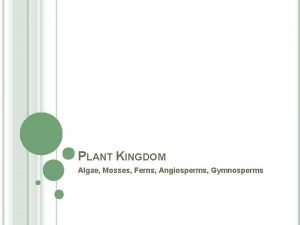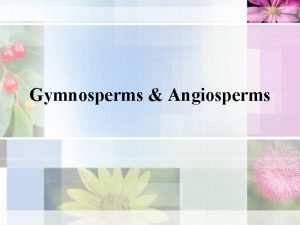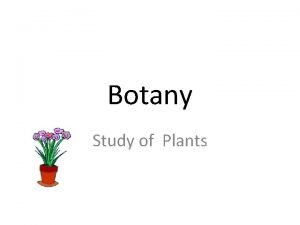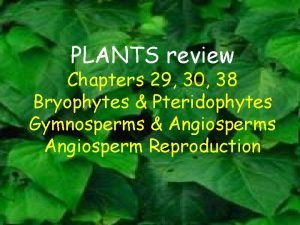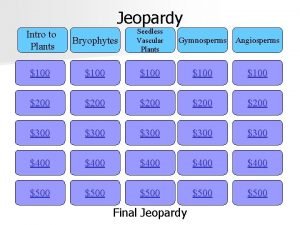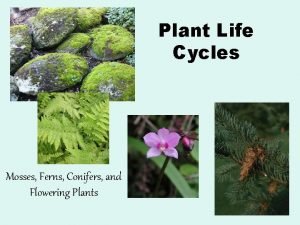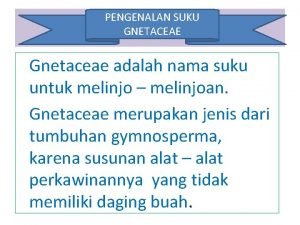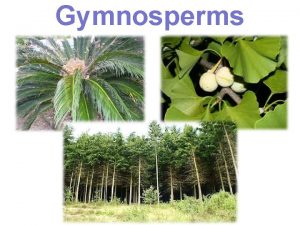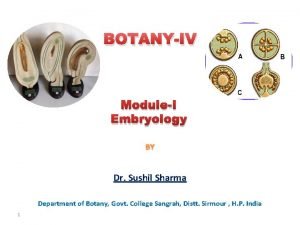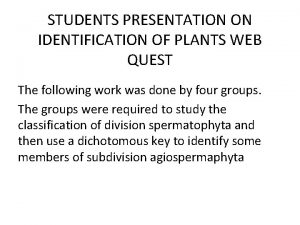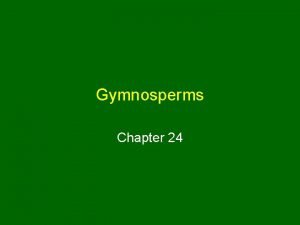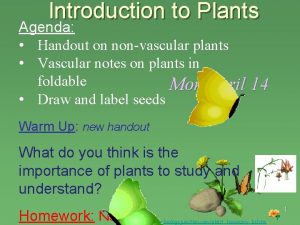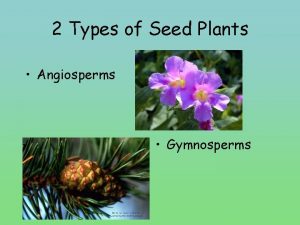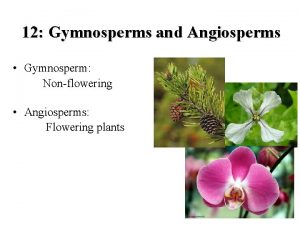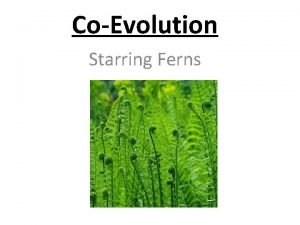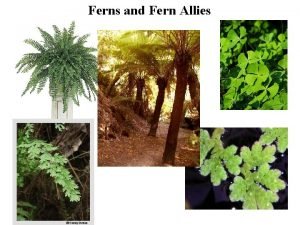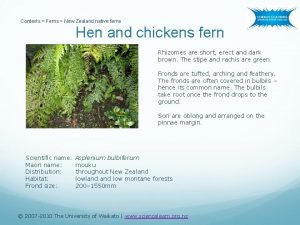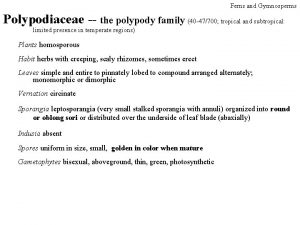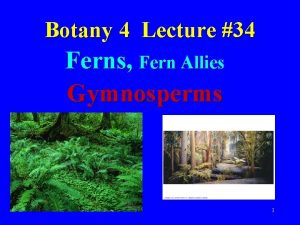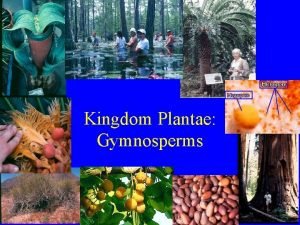Ferns Gymnosperms Angiosperms Gnetum Description some apply to















- Slides: 15


Ferns Gymnosperms Angiosperms

Gnetum • Description: (some apply to other Gnetales) – Monoecious or dioecious – Stems woody (mainly vines), swollen nodes, vessels (up to 300 um) with vestured pits and fibers, high photosynthetic and transpiration capacities, syringaldehyde lignin, tunica presence outer apical meristem (1 cell wide not two) • Vessels derived from tracheids with circular pits (Angiosperms derived from tracheids with scalariform pits) – Leaves evergreen, opposite with reticulate venation and petioles, often drip tips, up to 10 cm wide • Fine venation is derived from fibers not vascular strands (Angiosperms)

Gnetum • Description: (some apply to other Gnetales) – “Flowers” in strobili: Reduced megagametophytes, Double fertilization (but no endosperm), Possibly entomophily, Outer envelope encloses ovule – Seeds drupe like in brightly colored fleshy “fruit” – Cotyledons 2 and epigeal – Ectomycorrhizal

Gnetum • But…sometimes gymnosperm like – Xylem can have tracheids with torus/margo pit – Root morphology – Circular border pitting

Habitat • Gnetum: Tropical lowland rainforest • Ephedra: arid • Welwitschia: desert

Distribution • 40 species: 10 S. America, 1 W. Africa, 20 -25 Asia

Historical biogeography • Won and Renner (2006): – Divergence began in late Oligocene to mid. Miocene (~25 mya) – Asian clades diverging in Miocene to Pliocene (422 mya) – When did Gondwana break up? (~200 -250 mya) • African spp not a Gondwana relict! • Water dispersal is likely

Gnetum • First evidence of horizontal gene flow (Won and Renner 2003) – Gnetum and the asterid Petunia (2 -5 mya): nad 1 intron 2

Evolution of efficient xylem

Evolution of efficient xylem

Questions • Based on habit, xylem, and leaves, is Gnetum a weedy-disturbance specialist with fast photosynthetic and water transport rates? – Conducted field measures of hydraulic conductivity, photosynthesis and stomatal conductance in PNG with 2 tree and 2 liana Gnetum species (as well as a Podocarpaceae and 11 Angiosperms)



Questions • Based on habit, xylem, and leaves, is Gnetum a weedy-disturbance specialist with fast photosynthetic and water transport rates? – Answer: No, actually performed similarly to Podocarpaceae, except for Gs (transpiration rates), Ks (sapwood specific conductivity), and HV (Huber value; sapwood area/leaf area) – Vessels and pinnate-veined leaves may allow for greater light capture and growth under low light
 Mosses ferns conifers and flowering plants
Mosses ferns conifers and flowering plants Plants
Plants Types of angiosperm
Types of angiosperm Contrast gymnosperms and angiosperms
Contrast gymnosperms and angiosperms Reproduction in bryophytes ppt
Reproduction in bryophytes ppt Mosses are _____. bryophytes gymnosperms angiosperms
Mosses are _____. bryophytes gymnosperms angiosperms Angiosperm life cycle diagram
Angiosperm life cycle diagram Cross apply vs outer apply
Cross apply vs outer apply Gnetum monoecious
Gnetum monoecious Ciri gnetum gnemon
Ciri gnetum gnemon Gymnosperm life cycle
Gymnosperm life cycle Albuminous cells of gymnosperms are equivalent to
Albuminous cells of gymnosperms are equivalent to Gymnosperms phylum
Gymnosperms phylum Classification of gymnosperms ppt
Classification of gymnosperms ppt Seeds are present but naked in
Seeds are present but naked in Terrestrial plant
Terrestrial plant
